Jouhikko 1
The national instrument of Finland, the Jouhikko is a bowed lyre / psaltery. There is academic arguement that it belongs in the family with Kantele and Gusli, and there is reasonable justification for that placement rather than placement in the lyre family. But regardless of what word you use to describe it, it is an unusual instrument and quite a refreshing change to build.
Jouhikko had between 2 and 4 strings, and their existence has been traced at least as far back as the early 1500s, although many consider the instrument to have it's origin much farther back than that. The jouhikko is a drone instrument, with the center string set to a base tone (usually A in modern tuning) and the first (top) string set a 4th above. The chanter string (3rd string) is set a fifth above the center. Thus your playable scale is (in the case of an A drone tuning), d (open 1st string), e (open 3rd string), f (3rd string stopped with index finger), g (3rd string stopped with middle finger), a (3rd string stopped with ring finger), and b (3rd string stopped with pinky).
The instrument is held between the knees, and supported by the thumb and heel of the left hand, holding on to the thin bar on the outside of the handhole. The fingers are inserted through the handhole from behind, and the notes are played by stopping the strings with the knuckles of the left hand while bowing.
I apologise for the lack of detail construction pictures, but I built this instrument in primitive conditions at a week-long SCA event in a campground north of Kansas City, and while some folks did take some pictures of the work in progress, I have not rounded them up yet. This instrument was built with chisels and knives and planes and scrapers and sandpaper and handsaws and without the aid of modern power equipemnt. It was a neat exercise, and I plan to have one 'primitive' construction instrument going from now on at all times, that I can take to events or just work on in my shop. Keeps the hand skills sharp, causes you to keep an edge on tools you normally might ignore, and makes you appreciate what the early builders went through to make an instrument
The traditional construction of the jouhikko calls for horsehair strings, and thus this instrument is strung with twisted horsehair. When plucked, it has a sound like an African thumb-organ, with a mellow attack and little sustane and very fast decay. When bowed it is sweet and mellow, but not loud.
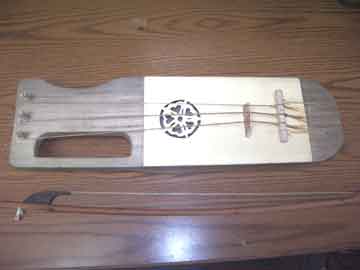
Top view os the finished instrument. 3 horsehair strings, maple bridge, spruce soundboard, ash pegs, maple tailbar, body is blue mahoe. I like this wood, it works very much like a walnut, finishes nicely with a natural dry satin feel and look, and has a beautiful color reminiscent of english walnut, with brown and grey base and blue and red and purple toned streaking. Really nice wood to work.
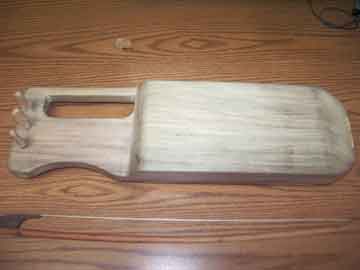
The bottom view - the grain of the blue mahoe is clear and straight, with speckled striations and a wide visual spectrum of color and tone. It is medium weight, string, and the tone of the hollow corpus was wonderful.
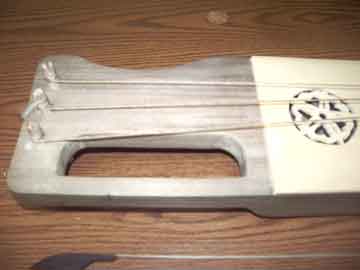
The pegs are ash, set in from the bottom to facilitate holding (although the horsehair tension is really not enough to cause great problems). They are slotted with big slots, so they are a bit bigger than most of my pegs which makes them strong, but also makes tuning a little more difficult, because small movement in the pegs moves the string a fair bit.
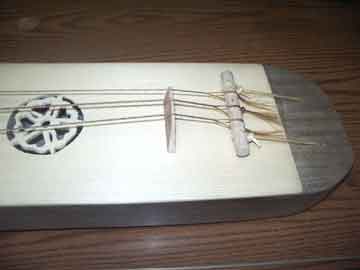
The tailpiece is like that used in kantele and gusli - a bar of wood. On this instrument the tailbar is suspended on a gut cord fed through the solid tail end of the instrument. The strings are parted in half, and draped over the bar, then twisted and pulled over the bridge and into the pegs. I am still experimenting on the string diameters, but I am using raw siberian mare hair (unbleached) for the string material - I got it from a violin repairman. The rosette is a tudor rose, I was talked into this rather than my usual Cross Calatrava because some members of my group wanted me to enter this instrument into a 'Rose in any medium" competition held at the event it was built at. It was the hardest part of the project, and still needs some cleaning up.
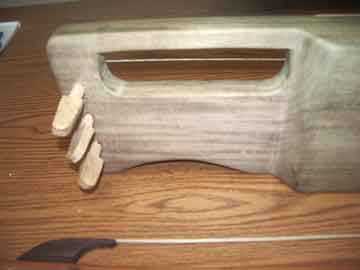
You can see the single chanter string through the handhole, and the hand carved tuning peg heads in this shot.
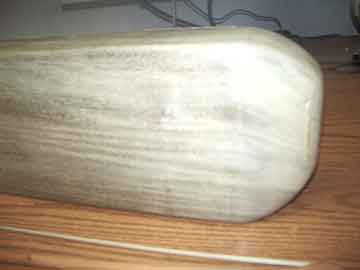
The tailgut goes through the end of the body - the front couple inches are solid, and there is no worry about stress. It is a very secure method of attaching tailgut.
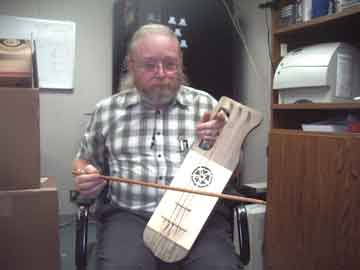
An idea of the size of the instrument, and the proper playing position as far as I can tell. I am using my rebec bow on it but am trying to find a proper bent wood stick to make a jouhikko bow out of - it is a fun instrument and I find it is easier to get music out of than my other fiddle-like instrument.
Next might just be an electric jouhikko - I found the electrossingen to be a big plus when playing for a moderately sized tent in a medium rain the amp really let the instrument be heard over nature and the conversations taking place at the perimeter. This will not be my last bowed lyre, I am looking at Estonian instruments and a strakkaharpa for the next ones, and my littlest daughter is so entranced with this one she wants to build one herself.
The national instrument of Finland, the Jouhikko is a bowed lyre / psaltery. There is academic arguement that it belongs in the family with Kantele and Gusli, and there is reasonable justification for that placement rather than placement in the lyre family. But regardless of what word you use to describe it, it is an unusual instrument and quite a refreshing change to build.
Jouhikko had between 2 and 4 strings, and their existence has been traced at least as far back as the early 1500s, although many consider the instrument to have it's origin much farther back than that. The jouhikko is a drone instrument, with the center string set to a base tone (usually A in modern tuning) and the first (top) string set a 4th above. The chanter string (3rd string) is set a fifth above the center. Thus your playable scale is (in the case of an A drone tuning), d (open 1st string), e (open 3rd string), f (3rd string stopped with index finger), g (3rd string stopped with middle finger), a (3rd string stopped with ring finger), and b (3rd string stopped with pinky).
The instrument is held between the knees, and supported by the thumb and heel of the left hand, holding on to the thin bar on the outside of the handhole. The fingers are inserted through the handhole from behind, and the notes are played by stopping the strings with the knuckles of the left hand while bowing.
I apologise for the lack of detail construction pictures, but I built this instrument in primitive conditions at a week-long SCA event in a campground north of Kansas City, and while some folks did take some pictures of the work in progress, I have not rounded them up yet. This instrument was built with chisels and knives and planes and scrapers and sandpaper and handsaws and without the aid of modern power equipemnt. It was a neat exercise, and I plan to have one 'primitive' construction instrument going from now on at all times, that I can take to events or just work on in my shop. Keeps the hand skills sharp, causes you to keep an edge on tools you normally might ignore, and makes you appreciate what the early builders went through to make an instrument
The traditional construction of the jouhikko calls for horsehair strings, and thus this instrument is strung with twisted horsehair. When plucked, it has a sound like an African thumb-organ, with a mellow attack and little sustane and very fast decay. When bowed it is sweet and mellow, but not loud.

Top view os the finished instrument. 3 horsehair strings, maple bridge, spruce soundboard, ash pegs, maple tailbar, body is blue mahoe. I like this wood, it works very much like a walnut, finishes nicely with a natural dry satin feel and look, and has a beautiful color reminiscent of english walnut, with brown and grey base and blue and red and purple toned streaking. Really nice wood to work.

The bottom view - the grain of the blue mahoe is clear and straight, with speckled striations and a wide visual spectrum of color and tone. It is medium weight, string, and the tone of the hollow corpus was wonderful.

The pegs are ash, set in from the bottom to facilitate holding (although the horsehair tension is really not enough to cause great problems). They are slotted with big slots, so they are a bit bigger than most of my pegs which makes them strong, but also makes tuning a little more difficult, because small movement in the pegs moves the string a fair bit.

The tailpiece is like that used in kantele and gusli - a bar of wood. On this instrument the tailbar is suspended on a gut cord fed through the solid tail end of the instrument. The strings are parted in half, and draped over the bar, then twisted and pulled over the bridge and into the pegs. I am still experimenting on the string diameters, but I am using raw siberian mare hair (unbleached) for the string material - I got it from a violin repairman. The rosette is a tudor rose, I was talked into this rather than my usual Cross Calatrava because some members of my group wanted me to enter this instrument into a 'Rose in any medium" competition held at the event it was built at. It was the hardest part of the project, and still needs some cleaning up.

You can see the single chanter string through the handhole, and the hand carved tuning peg heads in this shot.

The tailgut goes through the end of the body - the front couple inches are solid, and there is no worry about stress. It is a very secure method of attaching tailgut.

An idea of the size of the instrument, and the proper playing position as far as I can tell. I am using my rebec bow on it but am trying to find a proper bent wood stick to make a jouhikko bow out of - it is a fun instrument and I find it is easier to get music out of than my other fiddle-like instrument.
Next might just be an electric jouhikko - I found the electrossingen to be a big plus when playing for a moderately sized tent in a medium rain the amp really let the instrument be heard over nature and the conversations taking place at the perimeter. This will not be my last bowed lyre, I am looking at Estonian instruments and a strakkaharpa for the next ones, and my littlest daughter is so entranced with this one she wants to build one herself.
